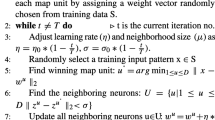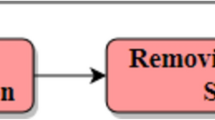Abstract
Clustering is an unsupervised classification task in data mining, which partitions data set into certain number of clusters. Though many metaheuristics have been suggested to optimize clustering results, most of them are marred by the three key issues. First, clustering performance is devised on a single validity measure; hence, it produces a single best solution biased toward the criterion; it is unacceptable as clustering has multiple conflicting criteria. Second, they find difficulty in avoiding local optima owing to lack of balancing in exploration and exploitation in the search space. Third, they require number of clusters a priori which is difficult to decide in the real-world problems. To deal with the first issue, we follow Pareto-based approach to obtain diverse trade-off solutions by optimizing conceptually contradicting validity measures sum of squared error and connectedness. The well-known swarm intelligence-based metaheuristic particle swarm optimization (PSO) has a severe drawback that it converges prematurely owing to single directional information sharing mechanism among particles in the swarm. Therefore, for the second issue, we introduce fitness predator optimizer (FPO) to enhance diversity in the PSO in multi-objective optimization scenario; it is named as FPO-MOPSO. To address the third issue, we use dynamic clustering method to decide an optimum number of clusters (k) in the range of 2 to \(\sqrt{n}\), where n is number of objects in the data set. We use eight real-world and two artificial data sets for comparison of the FPO-MOPSO results with three well-known competitive methods MOPSO, MABC, and NSGA-II using four quality measures convergence, diversity, coverage, and ONVG. The obtained results show superiority of the FPO-MOPSO over its competitors. Two external validity indices of clustering results F-measure and Rand index also establish the above finding. As the decision maker picks only a single solution from the set of trade-off solutions, we employ an additional measure silhouette index to select a final single solution from the archive and compare it with known number of clusters in the data sets.



Similar content being viewed by others
Explore related subjects
Discover the latest articles and news from researchers in related subjects, suggested using machine learning.References
Abubaker, A., Baharum, A., Alrefaei, M.: Automatic clustering using multi-objective particle swarm and simulated annealing. PLOS ONE 10(7), e0130–995 (2015)
Akbari, R., Hedayatzadeh, R., Ziarati, K., Hassanizadeh, B.: A multi-objective artificial bee colony algorithm. Swarm Evol. Comput. 2, 39–52 (2012)
Bahrololoum, A., Nezamabadi-pour, H., Saryazdi, S.: A data clustering approach based on universal gravity rule. Eng. Appl. Artif. Intell. 45, 415–428 (2015)
Bandyopadhyay, S., Maulik, U., Mukhopadhyay, A.: Multiobjective genetic clustering for pixel classification in remote sensing imagery. IEEE Trans. Geosci. Remote Sens. 45(5), 1506–1511 (2007)
Coello, C.A.C., Pulido, G.T., Lechuga, M.S.: Handling multiple objectives with particle swarm optimization. IEEE Trans. Evol. Comput. 8(3), 256–279 (2004)
Corne, D.W., Jerram, N.R., Knowles, J.D., Oates, M.J., et al.: Pesa-ii: Region-based selection in evolutionary multiobjective optimization. In: Proceedings of the Genetic and Evolutionary Computation Conference (GECCO2001) (2001)
Deb, K.: Multi-objective Optimization Using Evolutionary Algorithms. Wiley-Interscience Series in Systems and Optimization. Wiley, London (2001)
Deb, K., Agrawal, S., Pratap, A., Meyarivan, T.: A fast elitist non-dominated sorting genetic algorithm for multi-objective optimization: Nsga-ii. Lect. Notes Comput. Sci. 1917, 849–858 (2000)
Evora, J., Hernandez, J.J., Hernandez, M.: A mopso method for direct load control in smart grid. Expert Syst. Appl. 42(21), 7456–7465 (2015)
Friedman, M.: The use of ranks to avoid the assumption of normality implicit in the analysis of variance. J. Am. Stat. Assoc. 32(200), 675–701 (1937)
Handl, J., Knowles, J.: Evolutionary multiobjective clustering. In: Yao, X., Burke, E.K., Lozano, J.A., Smith, J., Merelo-Guervós, J.J., Bullinaria, J.A., Rowe, J.E., Tiňo, P., Kabán, A., Schwefel, H.-P. (eds.) Parallel Problem Solving from Nature-PPSN VIII, pp. 1081–1091. Springer, Berlin (2004)
Handl, J., Knowles, J.: An evolutionary approach to multiobjective clustering. IEEE Trans. Evol. Comput. 11(1), 56–76 (2007)
Handl, J., Knowles, J.: Clustering criteria in multiobjective data clustering. In: Coello, C.A.C., Cutello, V., Deb, K., Forrest, S., Nicosia, G., Pavone, M. (eds.) Parallel Problem Solving from Nature-PPSN XII, pp. 32–41. Springer, Berlin (2012)
He, H., Tan, Y.: A two-stage genetic algorithm for automatic clustering. Neurocomputing 81, 49–59 (2012)
Hruschka, E.R., Campello, R.J.G.B., Freitas, A.A., De Carvalho, A.P.L.F.: A survey of evolutionary algorithms for clustering. IEEE Trans. Syst. Man Cybern. Part C Appl. Rev. 39(2), 133–155 (2009)
Jensi, R., Jiji, G.W.: An improved krill herd algorithm with global exploration capability for solving numerical function optimization problems and its application to data clustering. Appl. Soft Comput. 46, 230–245 (2016)
José-García, A., Gómez-Flores, W.: Automatic clustering using nature-inspired metaheuristics: a survey. Appl. Soft Comput. 41, 192–213 (2016)
Kao, Y., Chen, C.C.: Automatic clustering for generalised cell formation using a hybrid particle swarm optimisation. Int. J. Prod. Res. 52(12), 3466–3484 (2014)
Kaufman, L., Rousseeuw, P.J.: Finding Groups in Data: An Introduction to Cluster Analysis. Wiley, London (2009)
Kennedy, J., Eberhart, R.C.: C.: A discrete binary version of the particle swarm algorithm. In: Proceedings of the IEEE International Conference on Systems, Man and Cybernetics, Citeseer, pp. 4104–4109 (1997)
Kennedy, J., Eberhart, R., et al.: Particle swarm optimization. Proc. IEEE Int. Conf. Neural Netw. Perth Aust. 4, 1942–1948 (1995)
Kishor, A., Singh, P.K., Prakash, J.: Nsabc: non-dominated sorting based multi-objective artificial bee colony algorithm and its application in data clustering. Neurocomputing 216, 514–533 (2016)
Liu, R., Zhu, B., Bian, R., Ma, Y., Jiao, L.: Dynamic local search based immune automatic clustering algorithm and its applications. Appl. Soft Comput. 27, 250–268 (2015)
Mukhopadhyay, A., Maulik, U.: A multiobjective approach to mr brain image segmentation. Appl. Soft Comput. 11(1), 872–880 (2011)
Mukhopadhyay, A., Maulik, U., Bandyopadhyay, S.: A survey of multiobjective evolutionary clustering. ACM Comput. Surv. CSUR 47(4), 61 (2015)
Özyer, T., Liu, Y., Alhajj, R., Barker, K.: Multi-objective genetic algorithm based clustering approach and its application to gene expression data. In: Yakhno, T. (ed.) Advances in Information Systems. Springer, pp. 451–461 (2005)
Pakrashi, A., Chaudhuri, B.B.: A Kalman filtering induced heuristic optimization based partitional data clustering. Inform. Sci. 369, 704 (2016)
Prakash, J., Singh, P.K.: An effective multiobjective approach for hard partitional clustering. Memet. Comput. 7(2), 93–104 (2015)
Tan, S.C., Ting, K.M., Teng, S.W.: A general stochastic clustering method for automatic cluster discovery. Pattern Recognit. 44(10), 2786–2799 (2011)
Yang, S., Sato, Y.: Fitness predator optimizer to avoid premature convergence for multimodal problems. In: 2014 IEEE International Conference on Systems, Man and Cybernetics (SMC). IEEE, pp. 258–263 (2014)
Author information
Authors and Affiliations
Corresponding author
Rights and permissions
About this article
Cite this article
Prakash, J., Singh, P.K. & Kishor, A. Integrating fitness predator optimizer with multi-objective PSO for dynamic partitional clustering. Prog Artif Intell 8, 83–99 (2019). https://doi.org/10.1007/s13748-018-0157-5
Received:
Accepted:
Published:
Issue Date:
DOI: https://doi.org/10.1007/s13748-018-0157-5




